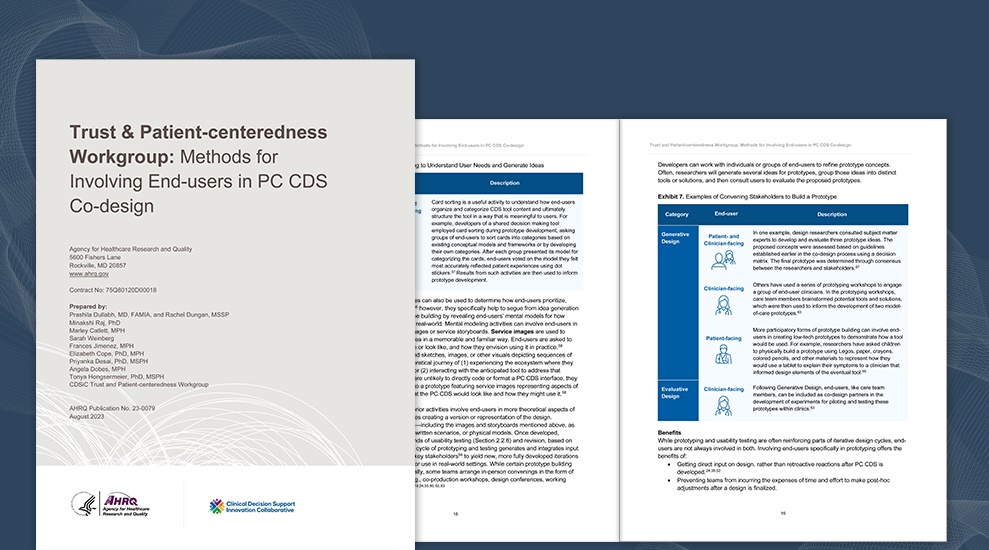
This resource paves the way for end users' involvement in codesign of patient-centered clinical decision support.
Developed by the AHRQ CDSiC Trust and Patient-Centeredness Workgroup, this resource focuses on codesign involving end users and other stakeholders as partners in developing, refining, and testing patient- and clinician-facing patient-centered clinical decision support.
Clinical decision support (CDS) development has historically been spearheaded by health systems leaders, electronic health record (EHR) developers, and informaticians. Unless CDS developers prioritize end-user needs and preferences or invite end-user input during design, patient-centered clinical decision support (PC CDS) may not align with clinician workflows or patient lifeflows. Codesign may help to prevent such unintended consequences by:
- Deepening developers’ understanding of the needs and challenges PC CDS end users face in their roles as clinicians, patients, caregivers, or other clinical decision-making partners.
- Inviting perspectives from other key stakeholders (e.g., health system leaders, vendor representatives) in the ecosystem, so that PC CDS design accounts for feasibility or other context considerations.
- Integrating different forms of knowledge (e.g., experiential vs. research expertise), and/or vantage points on PC CDS (e.g., clinician vs. patient perspectives) that each design partner can bring.
About the Report
Based on a literature review validated through key informant interviews, this report identifies a range of codesign methods that can be employed in different combinations during different phases of codesign. The report details the features and benefits of each method as well as key considerations when implementing codesign principles. Finally, the report presents a table and series of prompts that developers can consider when choosing methods that best meet their information needs and navigate their constraints throughout codesign. The report offers the following suggestions for successful codesign activities:
- Communicate clearly about expectations and roles/responsibilities of designers and end users.
- Demonstrate empathy and inclusivity.
- Develop methods for bidirectional communications between designers and end users.
- Invite and integrate different types of end-user contributions.
- Negotiate and resolve conflicts proactively and collaboratively to build trust and confidence in solutions.
- Establish an infrastructure for end users to easily access codesign platforms and supportive resources.
- Provide compensation to recognize end-users’ commitment and contribution.
How to Use This Report
This resource is primarily intended for those involved in designing and developing PC CDS. It can guide those seeking to use or promote PC CDS codesign by:
- Identifying and describing PC CDS codesign methods and their defining features.
- Describing tradeoffs (i.e., benefits vs. limitations), and the utility of each method during different phases of codesign (i.e., pre-design, design) to elicit information.
- Highlighting and sharing considerations for involving end users in PC CDS codesign.
Suggested Citation: Dullabh P, Dungan R, Raj M, Catlett M, Weinberg S, Jimenez F, Cope E, Desai P, Dobes A, Hongsermeier T, and the Trust and Patient-Centeredness Workgroup: Methods for Involving End-users in PC CDS Co-design. Prepared under Contract No. 75Q80120D00018. AHRQ Publication No. 23-0079. Rockville, MD: Agency for Healthcare Research and Quality; August 2023.





